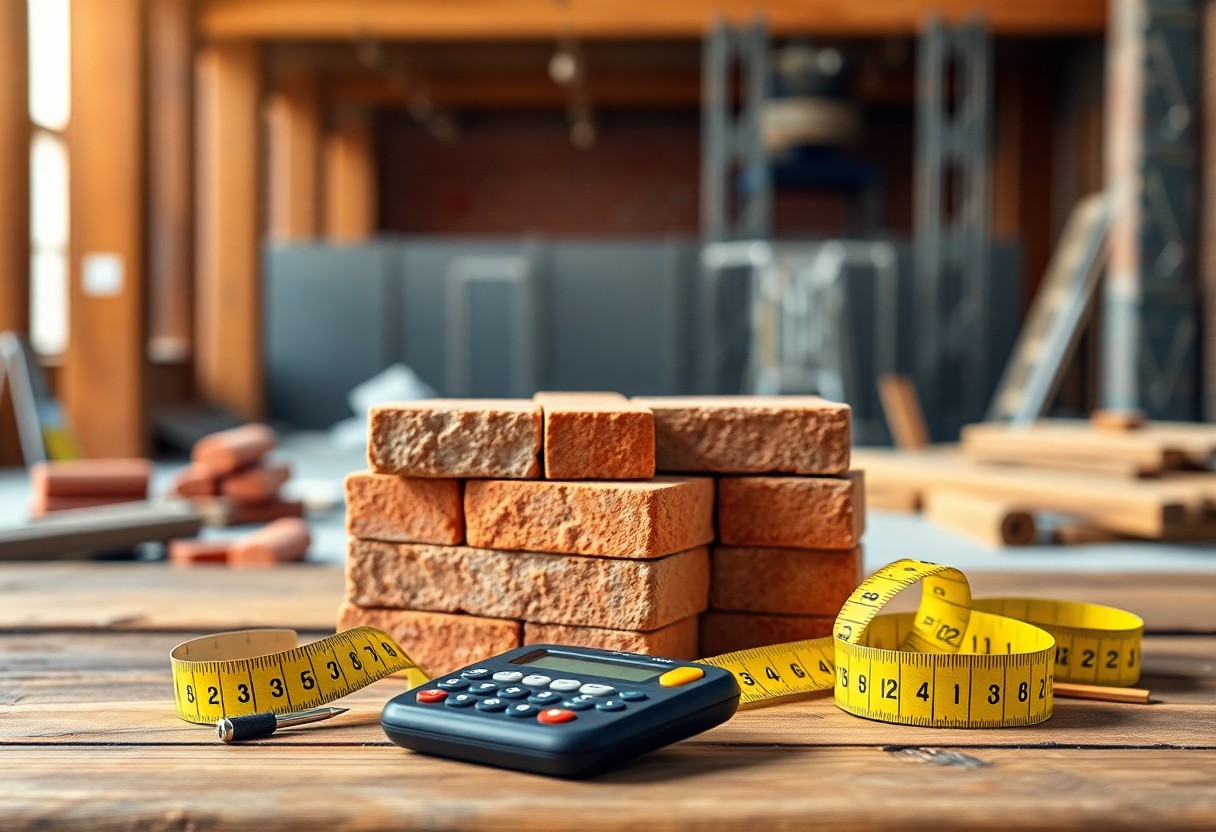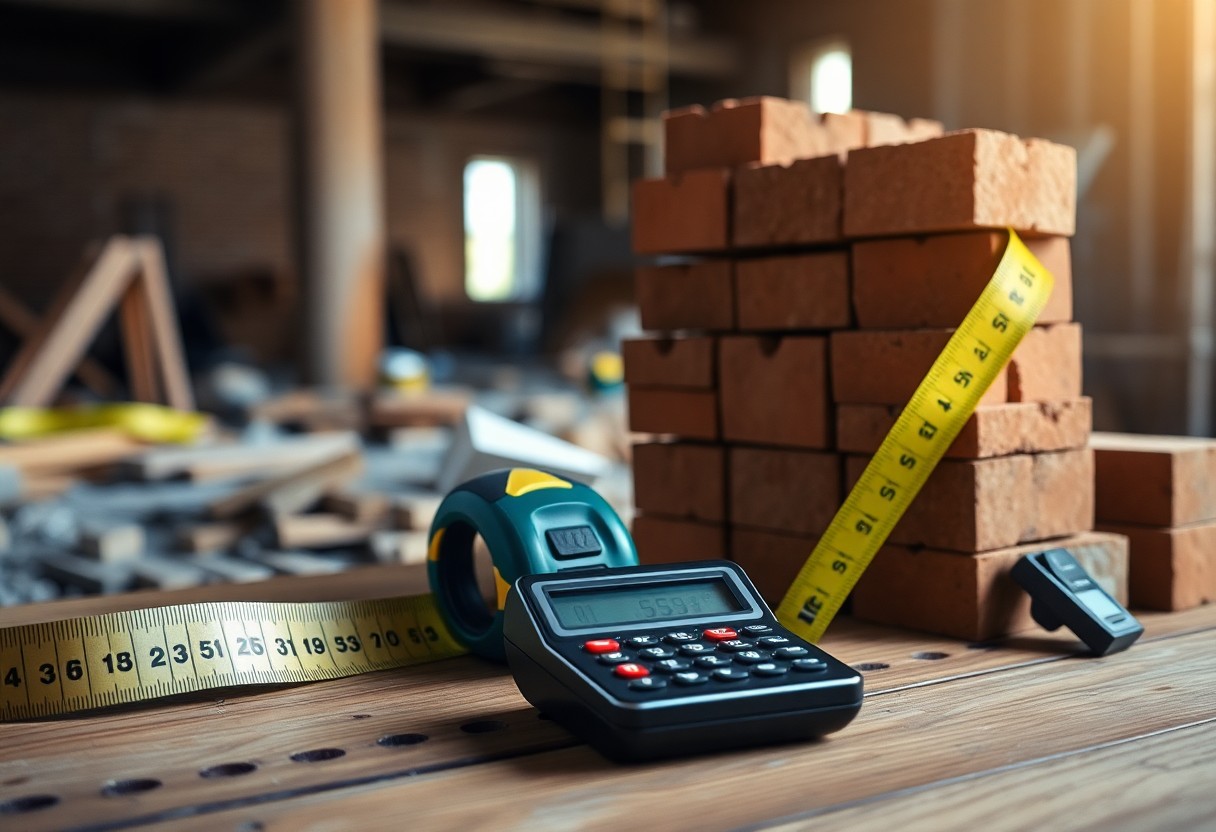Many DIY enthusiasts and construction professionals find themselves needing to determine the exact number of bricks required for a project. Whether you’re building a wall, a fireplace, or a garden feature, accurately calculating brick quantity is imperative for avoiding costly delays and ensuring a successful outcome. In this guide, you’ll learn the simple steps to estimate the number of bricks needed based on your specific dimensions, so you can confidently plan your next masonry project without overspending or running short. Let’s look into the calculations you’ll need.
Table of Contents
Key Takeaways:
- Determine the Area: Calculate the total area of the wall or structure to be built by measuring its height and width.
- Brick Dimensions: Know the dimensions of the individual bricks you’ll be using, including mortar space, to ensure accurate calculations.
- Account for Waste: Add approximately 10% to 15% to your calculated quantity to cover any potential breakage, cutting, or miscalculations.

Understanding Brick Quantity Calculations
Before you start your project, it’s imperative to grasp the fundamentals of brick quantity calculations. This understanding enables you to determine the number of bricks needed accurately, helping you stay within budget and avoid delays. Having a clear estimation also ensures that you account for waste and breakage, which is a common occurrence in construction.
Types of Bricks
Before determining the quantity, you need to understand the different types of bricks available, as this can significantly influence your calculations.
- Facing bricks – used for aesthetic purposes.
- Common bricks – primarily structural in nature.
- Refractory bricks – designed for high-temperature applications.
- Engineering bricks – known for low permeability and high strength.
- Concrete bricks – made from concrete for durability.
After identifying the appropriate type, you can proceed with your calculations.
| Type of Brick | Usage |
| Facing bricks | Aesthetic walls |
| Common bricks | Structural walls |
| Refractory bricks | High-temperature applications |
| Engineering bricks | Durability and strength |
Brick Dimensions and Volume
Brick dimensions play a vital role in determining the volume and quantity of bricks needed for your project. Each brick can vary in size, and knowing the standard measurements ensures you can perform accurate calculations.
This is where understanding the dimensions of bricks becomes imperative. Common sizes include standard bricks, which typically measure around 190mm x 90mm x 90mm. When calculating volume, you will multiply the dimensions to find the volume of a single brick and then apply that to the total area you plan to cover. Paying attention to wastage is also important, as you should consider at least 10-15% extra in your calculations to accommodate for breakage or miscalculations. Your accuracy in these calculations can lead to enhanced efficiency and reduced project costs.
Factors Affecting Brick Quantity
Any number of factors can influence the overall brick quantity needed for a project. Key considerations include:
- Wall design
- Thickness
- Mortar joints
- Wastage
After analyzing these elements, you can arrive at a more accurate estimation of materials required for your construction task.
Wall Design and Thickness
Affecting the quantity of bricks needed, the wall design and thickness play significant roles. Different designs such as single-layer or double-layer walls require varying amounts of bricks. Additionally, varying thicknesses can affect the total number of bricks needed, as thicker walls will naturally necessitate more units.
Mortar Joints and Wastage
You should account for mortar joints and potential wastage when calculating brick quantity. Each brick will require space for mortar, affecting how many bricks fit in a given area. Furthermore, site conditions can lead to wasted bricks due to breakage or miscalculations.
Another important aspect to consider is how mortar joints impact the total brick count. The width of these joints can vary based on the type of mortar used, which directly affects how many bricks are required. By accounting for wastage, you can safeguard against unexpected losses that may arise from handling errors or environmental conditions. Planning for at least 10% extra bricks is often a safe strategy, allowing you to proceed without delays due to shortages.

How to Calculate Brick Quantity Step-by-Step
Unlike complex construction methods, calculating brick quantity can be straightforward when you follow these simple steps. You need to first determine the area of the wall you want to build and then calculate the number of bricks required based on that area. The following table summarizes the crucial steps:
| Step | Action |
|---|---|
| 1 | Calculate the Area of the Wall |
| 2 | Determine the Number of Bricks Needed |
Calculating the Area of the Wall
Area is vital in determining the total surface you will cover with bricks. To calculate the area of the wall, measure the height and width and multiply these two dimensions together. This will give you the total area in square feet or meters.
Determining the Number of Bricks Needed
Bricks are calculated based on the area of the wall and the size of each brick. To find out how many bricks you need, you divide the total area by the area of a single brick, including the mortar space. This will provide you an approximate number but always add extra for breakage and waste.
A few tips include using standard brick sizes to simplify the calculation and adding an extra 10-15% to cover waste and cuts. Ensuring you have enough bricks, without overbuying, will keep your project on track and within budget. Having accurate measurements and taking care of brick quality will positively affect your wall’s integrity. Always try to consult with a professional to confirm your calculations.
Tips for Accurate Brick Calculations
To achieve precise brick quantity calculations, consider these helpful tips:
- Measure your wall dimensions accurately.
- Factor in mortar gaps between bricks.
- Consult local building codes for brick sizes.
- Verify the total number of bricks needed for any cuts or wastage.
Thou will find that attention to detail makes a significant difference in your project.
Tools and Resources
There’s a variety of tools and resources available to assist you in your brick calculation process. Consider using online calculators, mobile apps, or traditional measuring tools like tape measures and yardsticks. Additionally, reference materials like brick estimation guides can provide valuable insights and formulas that simplify your calculations.
Common Mistakes to Avoid
Any miscalculations can lead to material shortages or excess, disrupting your project. One common error is neglecting to account for mortar joints, which can result in purchasing inadequate bricks. Additionally, many overlook the importance of including wastage factors in their estimates, leading to unexpected delays. Thou should always double-check your measurements and calculations to avoid these pitfalls.
Another important mistake is not considering the brick pattern or layout you intend to use. A complex pattern may require additional bricks due to the need for cuts and adjustments. Additionally, failing to account for the thickness of mortar joints can affect the overall number of bricks required. By paying attention to these factors, you can ensure a smoother workflow and avoid the frustration of running out of materials mid-project, leading to compliant and successful results.
Adjusting for Special Situations
Keep in mind that when estimating brick quantities, special situations may arise that require adjustments to your calculations. Factors such as unique wall shapes or varying brick patterns can significantly affect the amount of material needed. Always account for these variations to ensure an accurate estimate and avoid unexpected shortages or excess of bricks.
Unique Wall Shapes
Now, if your project involves unique wall shapes, it’s necessary to adjust your brick quantity calculations accordingly. Irregular designs such as arches, curves, or angles may require additional bricks to accommodate their distinct dimensions. Consider creating a scaled drawing of the wall layout, so you can visualize and measure each section accurately.
Different Brick Patterns
Patterns play a significant role in determining how many bricks you will need for your project. A specific pattern not only affects the quantity but also influences the overall aesthetic of your construction. Common patterns like herringbone or basketweave may require more cuts and thus increase waste, so be sure to factor this into your brick count. The design you choose can create distinct visual impact; however, it is necessary to plan and calculate wisely to avoid overestimation or underestimation, which can lead to costly adjustments down the line.
Final Words
From above, you can see that calculating brick quantity involves assessing the dimensions of your wall and understanding the size of the bricks you plan to use. By knowing the area to be covered and factoring in mortar space, you can determine the number of bricks required accurately. For a detailed guide, refer to HOW TO CALCULATE BRICKS, CEMENT, AND SAND …. This will aid you in your construction project with precision and efficiency.
Q: What is the first step in calculating the quantity of bricks needed for a wall?
A: To start calculating the quantity of bricks for a wall, you need to determine the total area of the wall. Measure the height and width of the wall in meters and multiply these two dimensions to get the area in square meters. For example, if the wall is 2.5 meters high and 4 meters wide, the total area would be 2.5 x 4 = 10 square meters.
Q: How do I account for the size of the bricks when calculating the quantity?
A: The size of the bricks must be incorporated into your calculations. Standard brick sizes can vary, but a common size is 190mm x 90mm x 90mm. First, convert these dimensions into square meters (0.19m x 0.09m). Calculate the area of a single brick: 0.19 x 0.09 = 0.0171 square meters per brick. To find out how many bricks you need, divide the total wall area by the area of one brick. Continuing with the previous example, 10 sq meters / 0.0171 sq meters per brick = approximately 584 bricks.
Q: Should I include a waste factor when calculating the total number of bricks needed?
A: Yes, it is advisable to account for waste and breakage when estimating the number of bricks. A common recommendation is to add an extra 5% to 10% to your calculated total. This ensures that you have enough bricks to cover any losses due to cutting, breakage, or other unforeseen circumstances. For the previous calculation, if you determined you need 584 bricks, adding 10% would result in 584 + (0.10 x 584) = approximately 642 bricks to order.